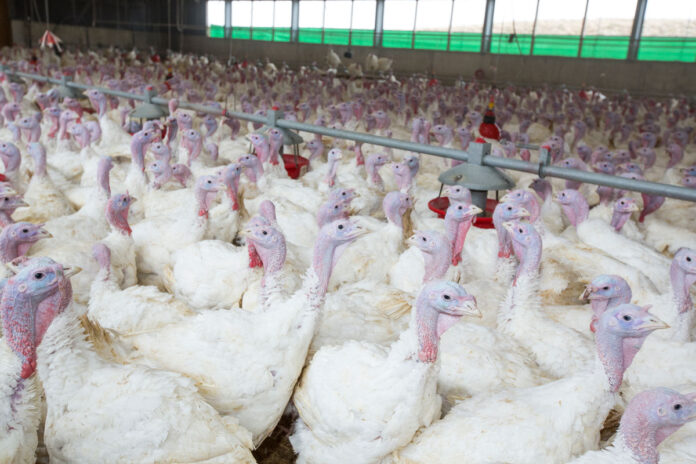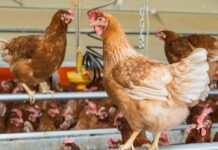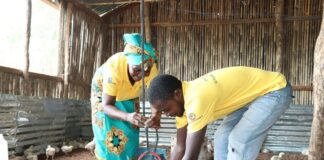
An effective flock health plan must integrate solid strategies for disease prevention, rapid diagnosis, and effective treatment to support poultry health. To attain this goal, proper biosecurity practices are a must to 1) prevent entry of potential pathogens (exclusion) and 2) avoid spreading diseases (containment). Successful on-farm implementation of both becomes producers’ best investment against health problems and disease outbreaks.
Exclusion practices to prevent diseases
The best strategy against any potential diseases is avoiding exposure. Certainly, proactive practices and well-design facilities that aim to prevent pathogen entry are greatly advised. For example, proper placement of feed bins and disposal containers outside the barn perimeter can allow refilling and removal of dead bodies with no need of trucks entering inside the fenced area (no cross contamination). Indeed, trucks impose a high biosecurity risk as they can visit multiple barns daily and relocate diseases across facilities into premises. If vehicles are to enter the fenced area, proper cleaning and disinfection should be done to deter disease transmission.
Pest control can also play a crucial role in disease prevention as rodents, wild birds, and insects can bring pathogens and parasites into poultry operations. If previously in contact with contaminated sources, flies (and other insects) can be carriers of foodborne diseases and viruses. Then, checking for entry points (like cracks and holes in ceiling, windows, filters, and walls), and fixing them, is a recommended, biosecurity-friendly strategy. As well, adequate management of carcass disposal to avoid cross contamination and cleaning up feed spillage as soon as possible help manage proliferation of insects, rodents, and other wildlife within poultry barns and premises. Feed storage facilities (and barn mills if applicable) must also be protected from contamination by wildlife. Dogs and cats can also carry over diseases and parasites, and their access to poultry barns must be off limits. Investing in efforts to block contact between commercial flocks and other animals, including insects, is key to lower chances for disease transmission, otherwise biosecurity is in jeopardy.
Most poultry facilities operate in an all-in/all-out basis depending on the production phase. Still, allocating a quarantine space for possible entries is advantageous to track the health status of arrivals and ease their transition into new houses prior to mixing. In case of a health problem, caretakers can act on it quickly and effectively due to small number of animals and reduced containment area. Also, when not in used as quarantine, this space can become a nursery area to manage sick birds and help birds left behind recover. Whether if used as quarantine or nursery area, taking the time to isolate potentially sick birds (either known or unknown) can help stop a possible disease outbreak on time.
Controlled access is a priority, and entry of personnel into premises and barns is a crucial step from a biosecurity standpoint. To safeguard poultry health, clean and dirty areas have to be clearly defined while staff and visitors cross correctly between them. During this step, nothing dirty must come in touch with anything in the clean area unless it has been cleaned and disinfected (including hands). In the locker room, street clothes should always remain in the dirty zone away from barn overalls and boots in the clean area. When moving between clean and dirty areas (both ways), showering and using hand sanitizers is desirable for pathogen exclusion and containment. Moreover, the locker room must also be cleaned and disinfected regularly at the end of the day. Relax biosecurity protocols when moving between dirty and clean areas can become a biosecurity breach that greatly put at risk poultry (and staff) health taking a toll on flock performance.
Containment tips for biosecurity
Proper cleaning followed by correct sanitation practices are farmer-best allies against potential pathogens and to get rid of any ongoing diseases. For this reason, easily cleanable surfaces (smooth concrete) and materials (like metal o plastic rather than wood) can be effortlessly disinfected and fumigated after cleaning. When not in used and during downtime between flocks, facilities and equipment need to be cleaned and sanitized regularly to prevent accumulation of organic waste and potentially infectious agents in poultry houses. Effective sanitation measures will help also prevent potential disease transfer from one flock to the next one. Yet, disinfectants are the most effective when used at the right concentration on clean surfaces, free of organic matter such as litter or manure. So, for successful sanitation, thorough cleaning is required followed by disinfectant application at the right dose and exposure time to kill bacteria and viruses.
Disease control is an integral part of bird welfare and health, and sanitation measures will help prevent disease transfer within and amongst flocks. Even when moving from younger to older flocks, cleaning and disinfecting hands and boots upon entry and exit is highly recommended for disease control. Particularly, if handling birds showing pathological symptoms or found dead to disallow cross contamination. Wearing disposal gowns and latex gloves is not practical for regular use on-farm, but placing disinfectant dispensers by entrance doors for easy utilization can mitigate disease transmission and help contain diseases if present.
Although these biosecurity practices are pricy and time consuming, ensuring that well laid-out biosecurity protocols are followed on-farm does pay off as the opportunities of disease transfer exponentially decline as the biosecurity level rises (particularly against local diseases). Also, to attain optimum bird performance, poultry health, and food safety, management practices that support hygienic conditions in and out of poultry barns are a requirement for high biosecurity standards. Economically, this translates into lower cost in terms of flock mortality, productivity loss, recovery time, stock replacement, and sanitation efforts.
But, what else?
Disease prevention is always a better option than treatment. Yet, to assess the effectiveness of biosecurity practices, regular monitoring and proper recording of poultry health is paramount to manage flock as soon as early signs show up in few chickens. Early disease detection is then equally important than prevention, and flocks should be carefully monitored regularly looking for acute symptoms (e.g., low body condition, poor feather coverage and cleanliness, breathing difficulties, litter quality). Once spotted, sick or injured birds must be promptly treated, moved to a recovery pen/room, or euthanized. Staff should also look at mortality and culling rates regularly to detect unusual records or worrying observations. Overall, beside solid biosecurity protocols, integrating other strategies that support poultry health (like a vaccination plan, probiotic administration, and prophylactic use of medications) are complementary approaches to secure poultry health and safeguard production outcomes.

















